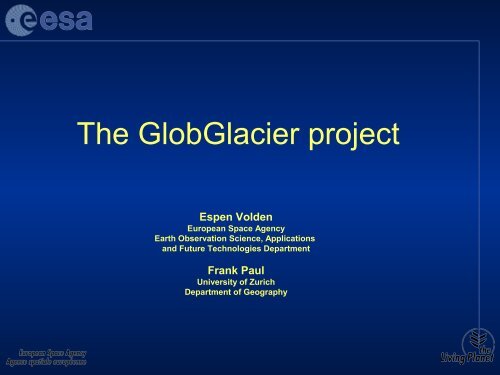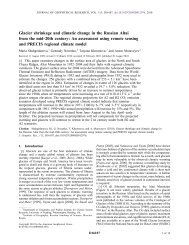The GlobGlacier project
The GlobGlacier project - GLIMS: Global Land Ice Measurements ...
The GlobGlacier project - GLIMS: Global Land Ice Measurements ...
Create successful ePaper yourself
Turn your PDF publications into a flip-book with our unique Google optimized e-Paper software.
<strong>The</strong> <strong>GlobGlacier</strong> <strong>project</strong>Espen VoldenEuropean Space AgencyEarth Observation Science, Applicationsand Future Technologies DepartmentFrank PaulUniversity of ZurichDepartment of Geography
<strong>The</strong> <strong>GlobGlacier</strong> <strong>project</strong>New activity within ESA’s Data User Element (DUE) programmeAim:Establish services for operational glacier monitoring from space,complementing and strengthening the existing services and networkUsers:Science community studying glaciers in the context of climatechangeBudget:950 K€
<strong>The</strong> <strong>GlobGlacier</strong><strong>project</strong>ObjectivesProducts responding to• Operational needs & requirements of a certain number of userswho will be actively involved in the <strong>project</strong>• Requirements of the GCOS implementation plan for UNFCCC& GCOS "Systematic Observation Requirements for SatellitebasedProducts for Climate"Priority application areas:• complementing and completing the WGI with 2D vector outlines• changes in glacier length, size, and volume• global trends of climate change and sea level rise contribution
Service extent<strong>The</strong> <strong>GlobGlacier</strong><strong>project</strong>Total number of glaciers to be investigated will vary according to theinformation products: from selected mass balance glaciers to tens ofthousands of glaciers worldwideGeographical areas: glaciers from at least• Europe – Alpes• Europe – North• Africa• Asia• South-America• North America• New ZealandTime period:Glaciers will also be analyzed over time, going back 10-20 years.
User requirements meetings22-23 June 2006, University of Zurich16 August 2006, Cambridge<strong>The</strong> <strong>GlobGlacier</strong><strong>project</strong>Objectives: Define requirements for the information products tobe developed and implemented in the <strong>GlobGlacier</strong> <strong>project</strong>Output of the meeting:• A user requirements document with six products• Confirmed interest from meeting participants to participate• Document for a proposed co-operation between <strong>GlobGlacier</strong> andthe GLIMS initiative
<strong>The</strong> <strong>GlobGlacier</strong><strong>project</strong>• WGMSInvolved user groups:• GLIMS• scientists (cryosphere, climate modelling, sea-level-rise)• GTOS/GCOSInterested users:• UNESCO (GRID-Geneva)• hydrological programmes and organisations• further scientists and the general public
Areas of interest:• Representative key regions (without the two Ice Sheets)• entire mountain ranges or massifs• several 10’000 km 2Selection criteria for representative regions:Climate change detection:• Include and extend available long-term in-situ measurements• Bridge geographic gaps of the world glacier inventory (WGI) also withrespect to DEM coverage (outside SRTM)• include different glacier geometries (size, aspect, dynamics, …)Sea level rise:• Large area covered, climatically sensitive regionClose coordination with GLIMS and WGMS<strong>The</strong> <strong>GlobGlacier</strong><strong>project</strong>
<strong>The</strong> <strong>GlobGlacier</strong><strong>project</strong>Products2. Area: Digital map of glacier outlines + a level 2 product that canreadily be ingested into the GLIMS database (including individualglaciers with topographic parameters)3. Snowline: Position of the end of summer snowline (ELA) for massbalance determination4. Terminus position: Coordinates of lowest glacier elevation orvector line marking the terminus5. Topography: Digital map of surface elevation (DEM), both fromthe ice surface and outside6. Elevation change: Time slices of DEMs or point elevation trends7. Velocity: Velocity fields or velocities at individual points
Schedule• Planned start: Summer 2007• Duration: 3 years• Three <strong>project</strong> phases:- Definition phase (6 months)- Development phase (10 months)- Production and Validation Phase (20 months)
Organization of <strong>GlobGlacier</strong>• 5 consortium partners & 5 PhDs– Universities of Zurich (lead), Oslo and Edinburgh– Gamma Remote Sensing (CH) and ENVEO (AU)• 5 work packages covering the 6 products– each lead by one of the consortium members– close interactions among the WPs– full documentation of applied standards / techniques• Close interaction with user groups- 4 user meetings in Zurich defining the requirements,testing the products, reporting about the service- advisory board provides guidelines global outreach





